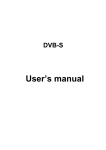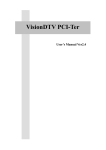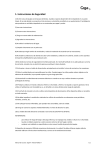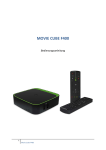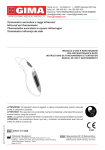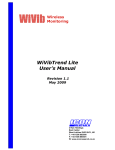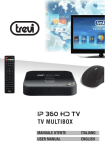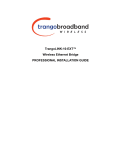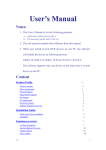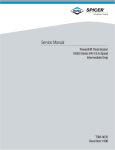Download Users Manual for more information.
Transcript
DVB-S User’s manual Content Chapter 1 DVB-S Introduction…………………………………2 1.1 product Introduction………………………………………..2 1.2 Features……………………………………………………...2 1.3 System Requirements………………………………………3 Chapter 2 Installation Guide……………………………………4 2.1 Hardware Installation……………………………………....4 2.2 Software Installation Before You Begin……………………….5 Chapter 3 Software Operation………………………………...12 3.1 LNB Setting………………………………………………...12 3.2 Channel Scanning………………………………………….18 3.3 Transponder Parameters………………………………….19 3.4 IP Receiver………………………………………………….21 Chapter 4 Application Programs ……………………………..24 4.1 Capture……………………………………………………..24 4.2 Scheduler Manager……………………………………......24 4.3 EPG………………………………………………………...27 4.4 SystemSetting……………………………………………...27 4.5 Function buttons overview………………………………..29 Appendix 1………………………………………………………..32 Appendix 2 Trouble Shooting……………………………...….33 Chapter 1 DVB-S Introduction 1.1 product Introduction DVB-S can implement IP data decoding and MPEG-2 A/V decoding. DVB-S can be widely used in software download, fast accessing internet, distance education, distance treatment,distance shopping, newspaper transmission system, video conference, and VOD, etc. DVB-S is based on an open system, supporting upgrade either from local disc or from internet. Note: This manual is only used for DVB-S product. 1.2 Features Fully compliant with DVB-DATA ETSI/EN 301 192 standard Fully compliant with supports DVB-S Protocol (EN 300 744) /MPEG-2 Support USB 2.0 Hi-Speed Input frequency: 950 MHz ~ 2150 MHz Symbol rate: 2~ 45 MS/s Compliant with TCP/IP, UDP protocol High-speed data download with FTP,HTTP and SMTP protocol Support for IP unicast and multicast Support DiSEqC1.0/1.2 protocol Max. 32PIDs can be decoded simultaneously Support Electronic Program Guide Support Multi-channel Recording Support TS Stream Recording Support Scheduler and Scheduler Play Support Parent Lock Support SDTV/HDTV Support Real Time Digital Video Recording (DVR) Support IR-Remote Controller LNB Power Supply: 13/18V <400mA (Note: Some features are only provided by content provider, be sure to check if your content provider supports them or not.) 1.3 System Requirements IBM PC compatible: Pentium III 667MHz or higher 128MBytes memory or more 32MBytes display memory or more Hard Disk free space of 500MBytes or more OS supported:Windows2000 for SP4/WindowsXP for SP2 (WindowsXP :Recommended) Chapter 2 Installation Guide 2.1 Hardware Installation 1.USB cards 2.USB device 2.1.1 DVB-S USB cards Before You Begin Make sure your computer system qualifies the system requirements Make sure the computer and peripheral equipments are power off Please note that the DVB-S USB card will not work when there is another TV tuner card onboard Step1: Insert DVB-S USB card into your PC. Step2: Connect your USB card with the antenna cable. 2.1.2 DVB-S USB device Step1: Connect the USB port of PC and DVB-S with USB cable Step2: Connect satellite signal to DVB-S Step3: Connect power socket and power on 2.2 Software Installation Before You Begin Make sure that the product is actually installed (for more information,please refer to Hardware Installation in the previous section). Turn on your computer/Restart your computer Step1: Cancel “New Hardware Wizard” After the computer is turned on, Windows will find New Hardware. Please choose “Cancel” from the pop up windows. We will install the driver later by the DVB-S installation program automatically. Step2: Activate DVB-S CD-ROM Insert the CD-ROM of DVB-S drivers into CD driver, the following picture will be displayed on the screen. If the following window does not appear, please open the “DVB-S” folder in CD-ROM. Step3: Install Driver Please select the “Install Driver” option, then Continuing to operate according to the prompt. When appearing the following picture,please click “Continue Anyway”,otherwise the driver installation would exit. Note:Installation need the normal connection of the apparatus at the driver, otherwise unable to urge to install. Step4: Install Application Program Please select the “Install Application” option and click it, then the following picture will appear.Also you can double click the file: “setup.exe” of DVB-S folder in the CD-ROM. Note:The destination folder can be changed if you like,and you can browse it. In the installation course,when pop up IP DATA reception function,you can choose to continue the installation of Network equipment drive program or to stop it if you don’t need it. Step5: Install Direct X 9.0 Please select “Install Direct X 9.0” option and click it, the following picture will display. Choose to accept the protocol,then click “next ”. After installation,it will restart your computer automatically. Step6: Install Adobe Reader If there is no Adobe Reader in your computer,you must install it so that you can scan the user’s manual. Step7: Install finished After installation, the icon of “DVBPlayer” will appear on the desktop and the program group will be created. Congratulations!You can double click the icon to run the control application program right now.At the same time,the icon will also appear on the desktop. Chapter 3 Software Operation First you open the software through double clicking the icon of “DVBPlayer” on the desktop.By this time you will see a window such as the following display. 3.1 LNB Setting In the main menu, click the right key on the mouse to display a list, and select “LNB Setting”. You can also click the button on the bottom-right of main menu to display the LNB Setting window. 3.1.1 Load Satellite In the above picture click “Load”to enter into Satellite loading window. There are many different satellites, load a default satellite in the transponder list. Click Load button under the satellite item. The following picture will display on the screen.Or you can choose the satellite you need. a) [Name] Press to display the drop-down list, and select the desired satellite from the list. Input the satellite name you want to add. b) [DiSEqC] The item is used to select the DiSEqC port. This is compatible with the DiSEqC 1.0 protocol. c) [Dual Oscillator] The Low Noise Block(LNB) is a combination of a low noise amplifier (LNA) and downconverter which built them into one device. One LNB has limited bandwidth, so we need two LNBs: low and high LNB. Select C band, Single or Double according to the type of dish you have.If you have select C Band, the frequency vales of low LNB is 5150.If you have single LNB mode, the frequency vales of low LNB is 11300.If you have dual LNB mode, to change the default value, click in the [Low LNB] and [High LNB], select needed frequencies from them. In this case, [22K] is inactive. d) [ToneBurst] Select [OFF] or [ON] in this column. 3.1.2 Add Satellite Add a new satellite in the transponder list. Click Add button under the Satellite item and select New again in the next submenu. 3.1.3 Modify Satellite Click [Modify] button in the [satellite] column. The satellite parameters dialog box will appear again. 3.1.4 Delete Satellite Delete a satellite in the transponder list. First select the satellite and press the Del button to delete it. 3.1.5 DiSEqC Setting DiSEqC1.2 is a special protocol for dish motor which drivers the dish to aim the satellite. a)[East/West] Drive the motor turn to East or West direction until unclinch it or reach the limit. b)[Software Limits] Set the east or west limit to ensure the motor will not reach the real limit. If not set a limit, the motor will continue to drive the dish to East or West although it can not turn east or west too much, the load of motor will be so large that it possibly will be damaged. c)[Position] Input the satellite position. d)[Angle] Degree:Enter the degree of the satellite position on the sky. e)[Reset] Click the Reset button to drive the dish to zero position. f)[Stop] Click the Stop button to stop the motor. g)[Close] Click the Close button to exit the window. 3.2 Channel Scanning Click the Scan button to display the Program Scan menu. In the menu, you can click the small pane to select transponder under the current satellite to search channels. You can also click the Select All button to select all transponder to scan channel.All the searched channels will be displayed in the bottom of the menu. 3.3 Transponder Parameters 3.3.1 Add transponder Add a new transponder in the transponder list. The following figure is transponder parameter dialog box. a) Name: Enter the new name of the TP. b) [Frequency(MHz)] This box indicates the down link frequency of the current transponder. c) [Symbol Rate(KS/s)] This box indicates the symbol rate of the current transponder. d) [Polarity] This box shows the LNB power supply mode. There are [Vertical], [Horizontal] polarization and [Disable] for your choice. 3.3.2 Modify transponder Click the [Modify] button in the [transponder] item. The transponder parameters dialog box will pop up again. 3.3.3 Delete transponder Delete a transponder in the transponder list. Select one transponder and press Del. 3.3.4 Scan Auto search all the programs. 3.4 IP Receiver This page shows the program table of the current transponder. You can setup the PID parameters which the satellite service provider offers. If there is no any setting about current transponder in transponder parameters item, all operations in this page are prohibited. Please add new transponder before you enter the following page. You can also double click the icon Receiver window. on the desktop to display the IP 3.4.1 Transponder The box shown all of the TPs under the current satellite. You can choose them. 3.4.2 Satellite The box shown all of the selected satellites. 3.4.3 Available PID Show searched data PID under the current transponder in the table. (Standard PID) 3.4.4 Active PID This item shows the current active PID. 3.4.5 PID(Hex) Input the data PID provided by your service provider. 3.4.6 Add PID Add PID value in [PID] and in Available PID table into active PID table. It can be added to 64 PIDs at the most. 3.4.7 Delete PID Delete the selected PID in the active PID table. 3.4.8 Filter Type Two filter types are available: MAC filter and Dial IP filter. MAC Filter: Filter data packets per the receiving box’s MAC address. If the destination address in the data packet is as the same as MAC address of the box, the packets will be received. If not, the packets won’t be received. Dial IP Filter: Filter data packets per the IP address assigned by server. 3.4.9 Unicast and Multicast MAC: To show the MAC address of the receiver box. Data Rate: To show unicast and multicast data rate in unit time. NOTE: In any circumstance the broadcast and multicast data will pass it. Chapter 4 Application Programs Functions 4.1 Capture Click the button to open the capture dialog box.When playing, click “Capture” button to capture one still picture and add to the capture window.Click “Save” to stored the captured picture. Click “Delete” to delete the selected picture from the storing folder. Click “Del ALL” to delete all the pictures showed on the capture window, and delete them in the storing folder. 4.2 Scheduler Manager Click the button to open the scheduler Manager dialog box,under the box include scheduler and scheduler play functions. Scheduler: Click “Refresh” button to refresh the status of one recording channel. Click “Stop” button to stop one recording channel. Click “Add” button to add one recording channel. Click “Delete” button to delete the recording channel. Click “Del Overdue” button to delete the overdue recording channel. Click “EPG” button to enter the EPG window. Note:You can set the start time and how long you want to record your favourite programs. When the program broadcasts to the time started that you established just now, it will record the program.You can browse the path of the file and rename the program.If you want to watch programs that you record and produce, click button , it will broadcast from TV window switch over to record programs window, then select the recording program that you want to watch from right column, pressing the right key can be loaded and recorded the file. Scheduler Play: Click “Add” button to add one channel that you want to play timely. Click “EPG” button to enter the EPG window. Click “Delete” button to delete the channel that you want to play timely. Click “Del Overdue” button to delete the overdue channel that you want to play timely. You can set the start time that you want to watch the program timely. When the program broadcasts to the time started that you established just now,it will switch the current program to the timely program automatically. 4.3 EPG Click the button to get EPG information of channel.This window includes scheduler and scheduler play functions.More details please refer to the descriptions above. 4.4 SystemSetting In the main menu, click the right key on the mouse to display the system setting menu. You can also click the “setting” on the file bar on the top of menu. 4.4.1 Path (1)Click the Browse button to select the path of the saved recording file. (2) Click the Browse button to select the path of the saved capturing picture. 4.4.2 Advanced (1)Decoder: Click the “ (2)Time Zone: Click the “ 4.4.3 Parent Lock ” to select the MPEG decoder. ” to select the time zone. When you want to set the password of some programs,you can start the parent lock function,input your password it will lock the program. 4.5 Function buttons overview 4.5.1 Play Click the button status. to play the selected channel, recording file in playing Click the button stop status. 4.5.2 Record to stop the selected channel, recording file in When playing live channel, click the button 4.5.3 Stop to start recording the video. When playing recording file, click the button to stop playing file. 4.5.4 Rewind When playing live channel in Time-Shifting status, click the button to rewind the Time-Shifting video buffer. And when playing recording file, rewind the file. 4.5.5 Fast Forward When playing live channel in Time-Shifting status, click the button to fast forward the Time-Shifting video buffer. And when playing recording file, fast forward the file. 4.5.6 Volume Speaker mute button. Volume control button. 4.5.7 Lists Click “Trans” to display all transponders. Click “Sat” to display all satellites. Click “Fav” to display all of the favorite channel. Click “All” to display all channels. Click “V” to display all TV program. Click “R” to display all Radio program. 4.5.8 Keyboard Shortcuts Function Play Pause Stop Capture Record Mute Left sound track Right sound track Full Screen Channel up Channel down Volume up Volume down Appendix 1 Remote Control Unit Keyboard Shortcut Ctrl+P Ctrl+T Ctrl+S Ctrl+C Ctrl+R Ctrl+M Ctrl+A Ctrl+D Alt+Enter ↓ ↑ → ← CH: Press to adjust the channel TAB:Press to switch among windows in the IP Data menu VOL: Press to adjust the volume PLAY/OK:Press to confirm the operation or show the program list ZOOM: Press to magnify the video from the current program MUTE: Press to suspend sound temporarily : Press to switch between operation and stand by modes EXIT: Return to the previous menu or escape item CAPTURE: Press to capture one still picture and add to the capture window : Switch back to previous channel PAUSE: Pause/Play A/V STOP: Press to stop recording or playing REC: Press to start record the video TV/F: Press to switch between playing and recording file mode Appendix 2 Trouble Shooting If any trouble in installation and operation of the DVB-S,please refer to this section or contact the after-sales service department. If the DVB-S can not be detected by Win98 / WinMe / Win2000 / WinXP during the installation, please check the following items: 1. Hardware: If the DVB-S can not be detected by Win98/WinMe/Win2000/ WinXP during the installation, please check the following items: (1) Check whether the USB jack of the PC and the USB cable is OK. (2) Check whether the power supply is OK. (3) Check whether the insertion of the box is OK. (4) Check whether the golden finger of the box is clean. If not, please clean them with alcohol or rubber. If the playing is not normally, please check whether the USB jack on PC support the USB2.0 HI-SPEED. If not receive signal, please check the following: (1) Check whether the signal cable connect to the LNB IN jack. (2) Check whether the satellite parameter is properly. 2 .Software: If the playing is not normally, please install the USB2.0 HI-SPEED drive. If don’t display the information of the current channel in the EPG window, or don’t search or playing channel, please install the Directx8.1 or the higher version.


































